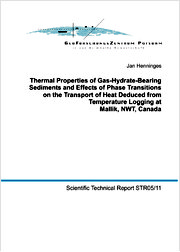| dc.contributor.author | Henninges, Jan | |
| dc.date.accessioned | 2010-10-28T18:46:27Z | |
| dc.date.available | 2010-10-28T18:46:27Z | |
| dc.date.issued | 2005 | |
| dc.identifier.uri | http://hdl.handle.net/11858/00-1735-0000-0001-32CB-1 | |
| dc.description.abstract | Detailed knowledge about the thermal properties of rocks containing gas hydrate is
required in order to quantify processes involving the formation and decomposition of
gas hydrate in nature. This work investigates the influence of methane hydrate on
the transport of heat in hydrate-bearing rocks. Both the thermal conductivity of gashydrate bearing sediments and the thermal effects of phase transitions are analyzed.
In the framework of the Mallik 2002 program three wells penetrating a continental gas
hydrate occurrence under permafrost were successfully equipped with permanent fiberoptic distributed temperature sensing cables. Temperature data were collected over a
period of 21 months after completion of the wells. The analysis of the disturbed well
temperatures after drilling revealed a strong effect of phase transitions on temperature
changes. For the first time, the effects of induced temperature changes within a gas
hydrate deposit were monitored in-situ. The resulting temperature gradient anomalies
could be successfully utilized to determine the base of the gas hydrate occurrences and
the permafrost layer at about 1103-1104±3.5 m and 599-604±3.5 m below ground level
respectively.
At the end of the 21-month observation period, the well temperature returned close to
equilibrium with the formation temperature. At the base of the gas hydrate occurrences
a temperature of 12.3 ◦C was measured, which is about 0.7 K below the stability
temperature predicted by thermodynamic calculations considering a pressure gradient
of 10.12 kPa m<sup>−1</sup> and a sea-water salinity of 35 ppt. Under the stated conditions, the
base of the stability zone of methane hydrate at Mallik would lie at about 1140 m below
ground level.
Thermal conductivity profiles were calculated from the geothermal data as well as
from a petrophysical model derived from the available logging data and application of
mixing-law models. The results indicate, that variations of thermal conductivity are
mainly lithologically controlled with a minor influence from hydrate saturation. The
results of the geometric mean model showed the best agreement to the thermal conductivity profiles derived from geothermal data. Average thermal conductivity values
of the hydrate-bearing intervals range between 2.35 W m<sup>−1</sup> K<sup>−1</sup> and 2.77 W m<sup>−1</sup> K<sup>−1</sup> .
A simplified numerical model of conductive heat flow was set up in order to assess the
temperature effect of phase transitions within the gas hydrate bearing strata. Within
the model the mobilization of latent heat during the phase transition was considered
(enthalpy method), taking into account the stability conditions for methane hydrate at
Mallik (pressure, temperature, pore fluid and gas phase composition) as well as effects of
hydrate decomposition on the thermal rock properties. The modelling results indicate,
that the regeneration of hydrate after the recovery of stability conditions is inhibited. | |
| dc.format.mimetype | application/pdf | |
| dc.language.iso | eng | |
| dc.publisher | GFZ, Helmholtz-Zentrum | |
| dc.rights.uri | http://e-docs.geo-leo.de/rights | |
| dc.subject.ddc | 551 | |
| dc.subject.gok | VRE 420 | |
| dc.subject.gok | VTV 100 | |
| dc.title | Thermal properties of gas hydrate bearing sediments and effects of phase transitions on the transport of heat deduced from temperature logging at Mallik, NWT, Canada | |
| dc.type | monograph | |
| dc.subject.gokverbal | Geochemische und physikalische Eigenschaften | |
| dc.subject.gokverbal | Kanada {Rohstoffgeologie} | |
| dc.identifier.doi | 10.23689/fidgeo-570 | |
| dc.identifier.ppn | 500662398 | |
| dc.type.version | publishedVersion | |
| dc.subject.free | gas hydrate | |
| dc.relation.volume | Scientific Technical Report / Geoforschungszentrum Potsdam; 2005, 11 | |
| dc.bibliographicCitation.journal | Scientific Technical Report / Geoforschungszentrum Potsdam | |
| dc.relation.collection | Geophysik | |
| dc.description.type | thesis | |


